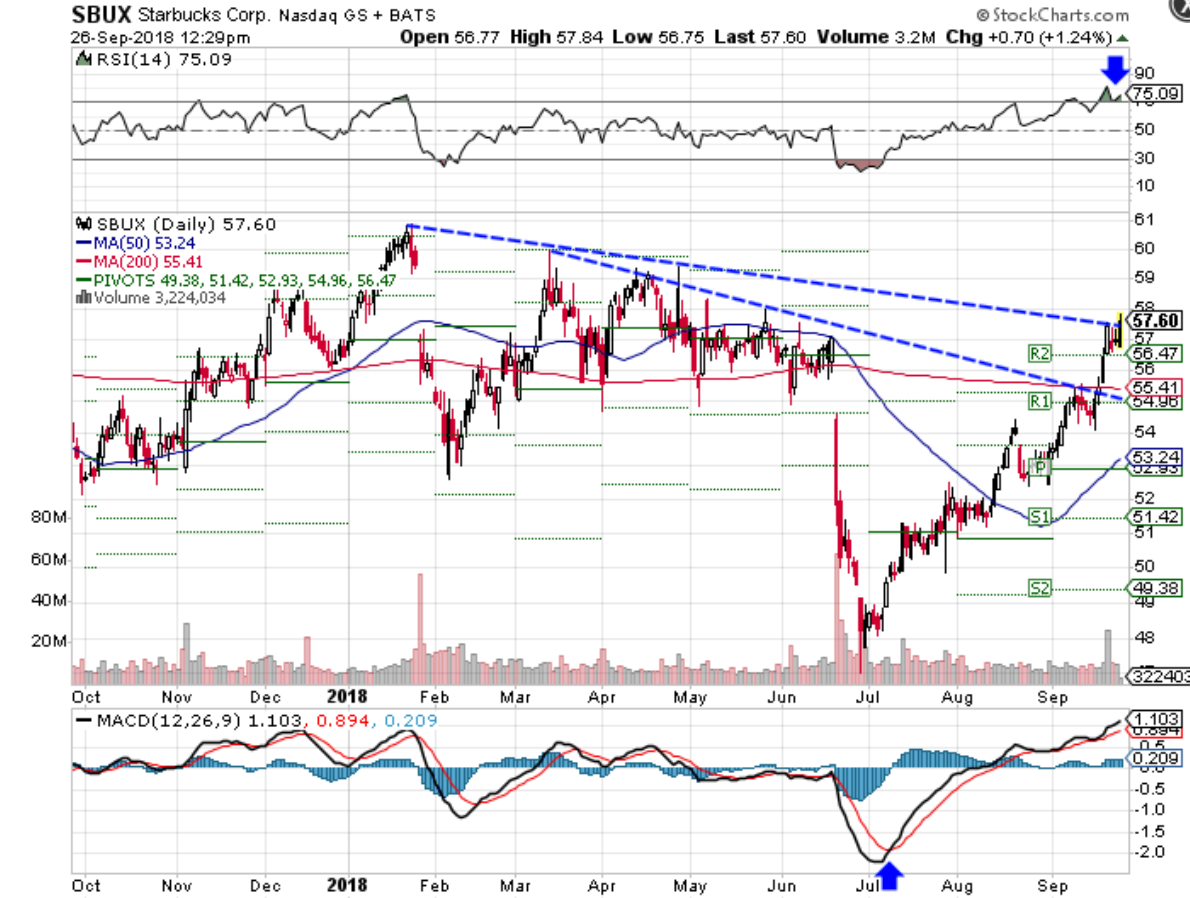Starbucks’ Financial Performance

Starbucks, a global coffeehouse giant, has consistently demonstrated strong financial performance over the years. This section delves into the company’s financial health, examining its revenue growth, profitability, and key financial decisions that have shaped its stock price.
Revenue Growth
Starbucks’ revenue has steadily increased over the past five years, showcasing its robust growth trajectory. The company’s expansion strategy, coupled with its focus on innovation and customer experience, has driven this growth.
- In fiscal year 2018, Starbucks’ revenue reached $24.7 billion, representing a 10% increase from the previous year.
- In fiscal year 2019, revenue further climbed to $26.5 billion, marking an 8% growth.
- Fiscal year 2020 witnessed a slight dip in revenue due to the COVID-19 pandemic, reaching $28.2 billion. However, the company swiftly adapted its operations, implementing digital initiatives and prioritizing safety measures, which helped mitigate the impact.
- In fiscal year 2021, Starbucks bounced back strongly, achieving revenue of $32.3 billion, a 14% increase compared to the previous year.
- Fiscal year 2022 saw continued growth, with revenue reaching $33.8 billion, representing a 5% increase.
Profitability Metrics
Starbucks’ profitability metrics are consistently above industry averages, demonstrating its efficient operations and strong brand recognition. The company’s profitability is measured through key metrics such as gross margin, operating margin, and net income margin.
- Starbucks’ gross margin has remained consistently above 60% in recent years, reflecting its ability to effectively manage its cost of goods sold.
- The company’s operating margin has also been strong, consistently exceeding 20%, highlighting its efficient operational model and ability to control operating expenses.
- Starbucks’ net income margin has consistently been in the range of 15% to 20%, indicating its strong profitability and ability to generate substantial net income.
Impact of Financial Decisions
Starbucks’ financial decisions have significantly impacted its stock price. For instance, the company’s strategic investments in digital initiatives, such as its mobile ordering and payment platform, have enhanced customer convenience and loyalty, driving revenue growth and positively influencing its stock price. Similarly, Starbucks’ focus on expanding into new markets, particularly in emerging economies, has contributed to its revenue growth and stock appreciation.
Financial Strengths and Weaknesses
Starbucks possesses several financial strengths, including its strong brand recognition, global reach, and efficient operational model. However, the company also faces certain financial weaknesses, such as its dependence on discretionary consumer spending and potential risks associated with its global expansion strategy.
- Starbucks’ strong brand recognition and customer loyalty provide a competitive advantage and contribute to its consistent revenue growth.
- The company’s global reach, with presence in over 80 countries, provides significant market access and growth opportunities.
- Starbucks’ efficient operational model, characterized by its focus on operational excellence and cost management, enables it to generate strong profitability.
- Starbucks’ dependence on discretionary consumer spending exposes it to economic downturns and shifts in consumer preferences.
- The company’s global expansion strategy, while offering growth potential, also carries risks associated with regulatory hurdles, cultural differences, and political instability in certain markets.
Starbucks’ Business Strategy and Operations: Sbux Stock

Starbucks’ success lies in its well-defined business model, which revolves around providing a premium coffee experience in a comfortable and inviting atmosphere. This model has allowed the company to establish a strong brand identity and cultivate a loyal customer base.
Starbucks’ Core Business Model and Competitive Advantages
Starbucks’ core business model focuses on offering high-quality coffee, tea, and other beverages, alongside pastries and snacks, in a welcoming and comfortable environment. This model is supported by several competitive advantages:
- Strong Brand Recognition: Starbucks’ iconic logo and green color scheme are instantly recognizable globally, contributing to its strong brand recognition and customer loyalty.
- Premium Coffee Experience: Starbucks sources its coffee beans from ethical and sustainable farms, ensuring high quality and flavor. The company also invests heavily in training its baristas to provide a consistent and exceptional coffee experience.
- Strategic Location Selection: Starbucks strategically locates its stores in high-traffic areas, ensuring maximum visibility and accessibility to its target customer base.
- Loyal Customer Base: Starbucks has successfully cultivated a loyal customer base through its reward programs and personalized experiences, encouraging repeat visits and increased spending.
- Effective Marketing Strategies: Starbucks utilizes various marketing channels, including social media, mobile apps, and partnerships, to reach its target audience and promote its products and services.
Starbucks’ Expansion Strategy and International Footprint
Starbucks has adopted a global expansion strategy, establishing a presence in over 80 countries and territories. This strategy aims to leverage the company’s brand recognition and proven business model to tap into new markets and grow its customer base.
- Strategic Acquisitions: Starbucks has acquired several international coffee chains, such as Seattle’s Best Coffee and Teavana, to expand its reach and product offerings.
- Joint Ventures: The company has also formed joint ventures with local partners in various countries to facilitate market entry and leverage local expertise.
- Franchising: Starbucks utilizes franchising as a key expansion strategy, allowing local entrepreneurs to operate stores under the Starbucks brand while benefiting from the company’s established systems and support.
Impact of Technological Advancements on Starbucks’ Operations
Starbucks has embraced technological advancements to enhance its operations and customer experience. These advancements have led to increased efficiency, personalized services, and data-driven decision-making.
- Mobile Ordering and Payment: Starbucks’ mobile app allows customers to order and pay for their drinks and food ahead of time, reducing wait times and streamlining the ordering process.
- Digital Menu Boards: Digital menu boards provide customers with up-to-date information about Starbucks’ offerings and promotions, enhancing their ordering experience.
- Data Analytics: Starbucks utilizes data analytics to understand customer preferences, optimize its product offerings, and personalize marketing campaigns.
Starbucks’ Commitment to Sustainability and Social Responsibility
Starbucks is committed to sustainability and social responsibility, incorporating these principles into its business practices and operations.
- Ethical Sourcing: Starbucks sources its coffee beans from ethical and sustainable farms, ensuring fair wages and safe working conditions for farmers.
- Environmental Stewardship: The company has set ambitious goals for reducing its environmental impact, including reducing greenhouse gas emissions and promoting waste reduction.
- Community Engagement: Starbucks actively engages with local communities through various initiatives, such as supporting education and providing opportunities for underprivileged youth.
Factors Influencing Starbucks’ Stock Price

The stock price of Starbucks, like any publicly traded company, is influenced by a complex interplay of factors. These factors can be categorized into macroeconomic, industry-specific, and company-specific elements, each contributing to the overall performance of the stock.
Macroeconomic Factors
Macroeconomic factors play a significant role in influencing Starbucks’ stock performance. These factors are broad economic trends that affect the overall business environment and consumer spending.
- Economic Growth: When the economy is growing, consumers tend to have more disposable income, leading to increased spending on discretionary items like coffee. This positive economic environment can boost Starbucks’ sales and profitability, driving up its stock price.
- Interest Rates: Interest rates affect the cost of borrowing for companies like Starbucks. Higher interest rates can make it more expensive for Starbucks to expand its operations or invest in new initiatives. This can negatively impact its earnings and, consequently, its stock price.
- Inflation: Inflation erodes the purchasing power of consumers. When inflation is high, Starbucks may need to raise prices to maintain its profit margins. However, price increases can impact consumer demand, potentially affecting Starbucks’ sales and stock performance.
- Currency Exchange Rates: Starbucks operates in numerous countries, and fluctuations in currency exchange rates can affect its financial performance. For example, a stronger US dollar makes Starbucks’ products more expensive in foreign markets, potentially reducing sales and profits. This can lead to a decline in its stock price.
Industry Trends, Sbux stock
The coffee industry is dynamic and constantly evolving, presenting both opportunities and challenges for Starbucks. Key industry trends that impact Starbucks’ business include:
- Shifting Consumer Preferences: Consumers are increasingly demanding high-quality, ethically sourced coffee and personalized experiences. Starbucks must adapt its offerings to meet these evolving preferences, investing in new products, sustainability initiatives, and innovative technologies.
- Competition: The coffee industry is highly competitive, with numerous local and international players vying for market share. Starbucks faces competition from specialty coffee shops, convenience stores, and even grocery chains. To maintain its market leadership, Starbucks needs to differentiate itself through innovation, customer loyalty programs, and a strong brand image.
- Technological Advancements: Technology is transforming the coffee industry. Mobile ordering, digital payment systems, and personalized recommendations are becoming increasingly popular. Starbucks must embrace these technologies to enhance customer experience, improve efficiency, and stay ahead of the competition.
Investor Sentiment and Market Expectations
Investor sentiment and market expectations play a crucial role in driving Starbucks’ stock price fluctuations.
- Earnings Reports: Investors closely watch Starbucks’ quarterly earnings reports for insights into its financial performance. Positive earnings surprises can boost investor confidence and drive up the stock price, while negative surprises can lead to a decline.
- Analyst Ratings: Stock analysts provide recommendations and price targets for Starbucks based on their assessment of its business prospects. Positive ratings and higher price targets can influence investor sentiment and push the stock price upwards. Conversely, negative ratings and lower price targets can dampen investor enthusiasm and lead to a decline.
- Market Volatility: General market conditions can impact Starbucks’ stock price. During periods of market volatility, investors may sell off stocks, including Starbucks, to reduce risk. This can lead to temporary declines in the stock price, even if Starbucks’ fundamentals remain strong.
Starbucks’ Dividend Policy
Starbucks’ dividend policy can also influence its stock price.
- Dividend Yield: Starbucks’ dividend yield, the annual dividend per share divided by the stock price, is a key factor for income-oriented investors. A higher dividend yield can attract investors seeking regular income, potentially increasing demand for the stock and driving up its price.
- Dividend Growth: Starbucks has a history of increasing its dividend payments over time. This demonstrates its financial strength and commitment to shareholder returns. Consistent dividend growth can signal confidence in the company’s future prospects, potentially leading to higher valuations and stock price appreciation.
- Dividend Payout Ratio: The dividend payout ratio, the percentage of earnings paid out as dividends, is another important consideration. A high payout ratio can indicate that Starbucks is returning a significant portion of its profits to shareholders. However, it can also suggest that the company has limited opportunities for reinvestment in its business, which may concern some investors.
Sbux stock has been on a rollercoaster ride lately, with investors closely watching the company’s performance under new leadership. The appointment of Starbucks CEO Laxman Narasimhan has brought renewed optimism, with his focus on innovation and customer experience. The future of Sbux stock hinges on his ability to navigate the evolving coffee market and deliver sustainable growth.
SBUX stock has been a popular choice for investors, reflecting the success of Starbucks as a global coffee giant. This success can be partly attributed to the leadership of individuals like Brian Niccol, whose own net worth is a testament to his business acumen.
You can learn more about Brian Niccol’s financial achievements and his impact on the business world by checking out brian niccol net worth. The insights gained from his story might provide a valuable perspective on the factors influencing the performance of SBUX stock.
